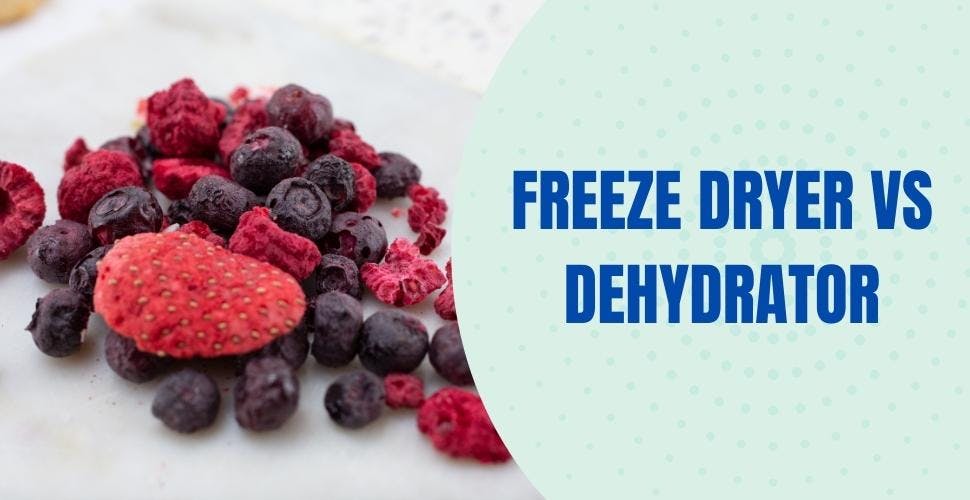Step-by-Step Guide to Freeze Drying
 Dr. Tontul
Dr. Tontul- 10 Aug 2023

Freeze drying is one of the best food preservation technique since it yields high-quality products in terms of physical and chemical properties.
In this article, we share a step-by-step guide from material preparation to packaging.
Step 1: Preparing the Material
Begin by selecting the suitable material for freeze drying. Most foods, from fruits to herbs, can undergo freeze drying. However, products rich in fat and sugar, such as honey, chocolate, butter, or nut butters, present challenges in freeze drying and are best avoided.
Once you've chosen the material, it's crucial to pre-process it. Thoroughly clean, wash, and remove any unsuitable materials. Ensuring the raw material's purity and suitability is vital for a successful freeze drying process.
Consider the size of the material as it directly impacts the duration and quality of freeze drying. Large materials should be cut or sliced into smaller pieces or processed into pulp or juice to increase efficiency and enhance the final freeze dried product's quality.
Pay attention to cutting or slicing the material into uniform sizes. Larger pieces require longer processing times, potentially leading to heterogeneity in the final product and reducing its shelf life.
Step 2: Freezing
The freezing stage significantly influences the quality of the end product. During freezing, ice crystals form within the material, and their size depends on the freezing speed.
To achieve superior results, opt for a higher freezing rate, which results in smaller ice crystals. The size of these ice crystals can impact the integrity of the cell structure and, in turn, affect the overall quality of the freeze dried material. Large ice crystals may have detrimental effects on cells and lead to a lower-quality final product.
To encourage a higher freezing rate, consider applying lower freeze temperatures and utilizing effective cold air movement in freeze dryer. While some freeze dryer machines can handle freezing, using external freezers is often recommended to ensure the highest quality outcome.
Step 3: Sealing the Drying Chamber
The freezing of the material can be done either on the shelves of the freeze dryer or externally. If freezing is performed without shelves, it's essential to cool the shelves separately to prevent risk of material melting.
Once the material is carefully arranged on the shelves, the next step is to seal the freeze drying chamber meticulously. Creating an airtight environment is paramount as sublimation occurs under specific pressure conditions. A well-sealed chamber ensures an optimal sublimation process during the freeze drying operation.
Step 4: Cooling the Coils
Upon starting the freeze dryer, the freezing coils in the condensation part are actively cooled. The water vapor released from the material during the sublimation process flows out of the freeze drying chamber and encounters the freezing coil.
In contact with the freezing coil, the water vapor condenses and transforms back into solid ice. The temperature of the freezing coils is typically set to be lower than -40°C (-40°F) to facilitate efficient condensation.
Cooling of the coils is important to extend the lifetime of the vacuum pump.
Step 5: Creating a Vacuum
Once the temperature of the freezing coils reaches the desired point, the vacuum pump is activated. This vacuum pump works to remove the air inside the drying chamber, effectively creating an airless environment. Maintaining the absolute pressure within the chamber below 0.06 atm is crucial for the success of the freeze drying process.
As the freeze drying chamber operates under reduced pressure, the frozen water within the material undergoes sublimation. Sublimation is an energy-intensive process, requiring additional heat to be applied to the dried material. The temperature at this stage is adjustable in most freeze dryers, allowing for precise control over the sublimation process. Consequently, the water molecules within the material directly transform into vapor and escape, leaving behind a perfectly freeze dried product.
During this step, generally frozen free water presented in the material is removed from the material.
Step 6: Desorption
In the freeze drying process, the phase of desorption plays a pivotal role in ensuring the longevity and superior quality of freeze dried foods. Desorption involves the removal of unfrozen bound water from the material by employing various mechanisms.
Unlike other drying methods, freeze drying's unique desorption phase contributes significantly to the extended shelf life of freeze dried foods. By efficiently removing the remaining bound water, freeze dried products attain a level of stability and preservation that is unmatched by conventional drying techniques.
Step 7: Completion and Packaging
Upon the completion of the freeze drying process, which typically spans over 20 hours, the material achieves a moisture content ranging from 1% to 5%. This results in a unique sponge-like microstructure that characterizes freeze dried foods.
You need do defrost your freeze dryer in this step. Check this to learn how you can do.
To ensure the long-lasting preservation and protection of the freeze dried foods, it is essential to package them promptly using mylar bags, jars, cans, or other suitable and moisture-resistant packaging materials. The air-tight packaging is vital in preventing any exposure to moisture, which could compromise the quality and freshness of the freeze dried products.
Step 8: Enjoying the Freeze Dried Foods
Congratulations! Your freeze dried products are now ready to use and can be kept for up to 30 years, which is an astoundingly long time. Whether you enjoy the delicious flavors and health advantages of natural foods or you are a survivalist, freeze drying offers a dependable and effective technique of preservation.
Enjoy your favorite freeze dried foods' exquisite textures, flavors, and nutritional value. Freeze dried foods are a desirable and adaptable addition to a variety of lifestyles due to their inherent ease, extended shelf life, and kept freshness.


